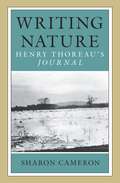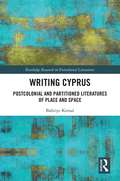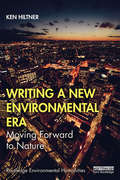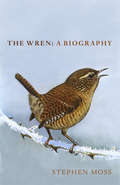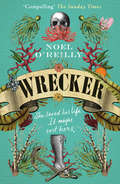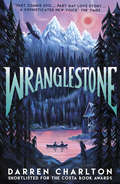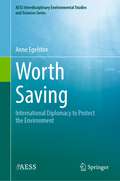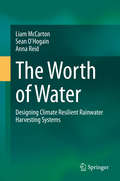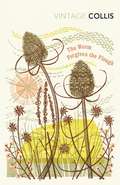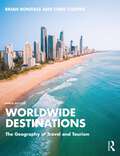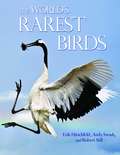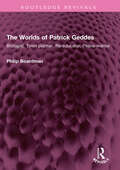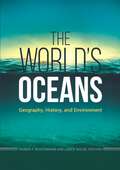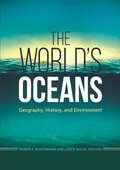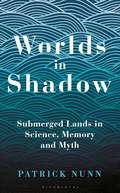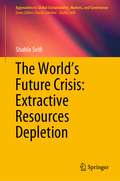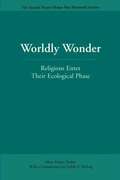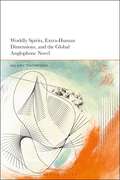- Table View
- List View
Writing Nature: Henry Thoreau's Journal
by Sharon CameronAt his death, Henry Thoreau left the majority of his writing unpublished. The bulk of this material is a journal that he kept for twenty-four years. Sharon Cameron's major claim is that this private work (the Journal) was Thoreau's primary work, taking precedence over the books that he published in his lifetime. Her controversial thesis views Thoreau's Journal as a composition that confounds the distinction between public and private—the basis on which our conventional treatment of discourse depends.
Writing Cyprus: Postcolonial and Partitioned Literatures of Place and Space (Routledge Research in Postcolonial Literatures)
by Bahriye KemalBahriye Kemal's ground-breaking new work serves as the first study of the literatures of Cyprus from a postcolonial and partition perspective. Her book explores Anglophone, Hellenophone and Turkophone writings from the 1920s to the present. Drawing on Yi-Fu Tuan’s humanistic geography and Henri Lefebvre’s Marxist philosophy, Kemal proposes a new interdisciplinary spatial model, at once theoretical and empirical, that demonstrates the power of space and place in postcolonial partition cases. The book shows the ways that place and space determine identity so as to create identifications; together these places, spaces and identifications are always in production. In analysing practices of writing, inventing, experiencing, reading, and construction, the book offers a distinct ‘solidarity’ that captures the ‘truth of space’ and place for the production of multiple-mutable Cypruses shaped by and for multiple-mutable selves, ending in a 'differential’ Cyprus, Mediterranean, and world. Writing Cyprus offers not only a nuanced understanding of the actual and active production of colonialism, postcolonialism and partition that dismantles the dominant binary legacy of historical-political deadlock discourse, but a fruitful model for understanding other sites of conflict and division
Writing Cyprus: Postcolonial and Partitioned Literatures of Place and Space (Routledge Research in Postcolonial Literatures)
by Bahriye KemalBahriye Kemal's ground-breaking new work serves as the first study of the literatures of Cyprus from a postcolonial and partition perspective. Her book explores Anglophone, Hellenophone and Turkophone writings from the 1920s to the present. Drawing on Yi-Fu Tuan’s humanistic geography and Henri Lefebvre’s Marxist philosophy, Kemal proposes a new interdisciplinary spatial model, at once theoretical and empirical, that demonstrates the power of space and place in postcolonial partition cases. The book shows the ways that place and space determine identity so as to create identifications; together these places, spaces and identifications are always in production. In analysing practices of writing, inventing, experiencing, reading, and construction, the book offers a distinct ‘solidarity’ that captures the ‘truth of space’ and place for the production of multiple-mutable Cypruses shaped by and for multiple-mutable selves, ending in a 'differential’ Cyprus, Mediterranean, and world. Writing Cyprus offers not only a nuanced understanding of the actual and active production of colonialism, postcolonialism and partition that dismantles the dominant binary legacy of historical-political deadlock discourse, but a fruitful model for understanding other sites of conflict and division
Writing a New Environmental Era: Moving forward to nature (Routledge Environmental Humanities)
by Ken HiltnerWriting a New Environmental Era first considers and then rejects back-to-nature thinking and its proponents like Henry David Thoreau, arguing that human beings have never lived at peace with nature. Consequently, we need to stop thinking about going back to what never was and instead work at moving forward to forge a more harmonious relationship with nature in the future. Using the rise of the automobile and climate change denial literature to explore how our current environmental era was written into existence, Ken Hiltner argues that the humanities—and not, as might be expected, the sciences—need to lead us there. In one sense, climate change is caused by a rise in atmospheric CO2 and other so-called greenhouse gases. Science can address this cause. However, approached in another way altogether, climate change is caused by a range of troubling human activities that require the release of these gases, such as our obsessions with cars, lavish houses, air travel and endless consumer goods. The natural sciences may be able to tell us how these activities are changing our climate, but not why we are engaging in them. That’s a job for the humanities and social sciences. As this book argues, we need to see anthropogenic (i.e. human-caused) climate change for what it is and address it as such: a human problem brought about by human actions. A passionate and personal exploration of why the Environmental Humanities matter and why we should be looking forward, not back to nature, this book will be essential reading for all those interested in the future and sustainability of our planet.
Writing a New Environmental Era: Moving forward to nature (Routledge Environmental Humanities)
by Ken HiltnerWriting a New Environmental Era first considers and then rejects back-to-nature thinking and its proponents like Henry David Thoreau, arguing that human beings have never lived at peace with nature. Consequently, we need to stop thinking about going back to what never was and instead work at moving forward to forge a more harmonious relationship with nature in the future. Using the rise of the automobile and climate change denial literature to explore how our current environmental era was written into existence, Ken Hiltner argues that the humanities—and not, as might be expected, the sciences—need to lead us there. In one sense, climate change is caused by a rise in atmospheric CO2 and other so-called greenhouse gases. Science can address this cause. However, approached in another way altogether, climate change is caused by a range of troubling human activities that require the release of these gases, such as our obsessions with cars, lavish houses, air travel and endless consumer goods. The natural sciences may be able to tell us how these activities are changing our climate, but not why we are engaging in them. That’s a job for the humanities and social sciences. As this book argues, we need to see anthropogenic (i.e. human-caused) climate change for what it is and address it as such: a human problem brought about by human actions. A passionate and personal exploration of why the Environmental Humanities matter and why we should be looking forward, not back to nature, this book will be essential reading for all those interested in the future and sustainability of our planet.
The Wren: A Biography
by Stephen MossFrom the bestselling author of The Robin: A BiographyThe wren is a paradox of a bird. On the one hand wrens are ubiquitous. They are Britain’s most common bird, with 8.5 million breeding pairs and have by far the loudest song in proportion to their size. They also thrive up and down Britain and Ireland: from the smallest city garden to remote offshore islands, blustery moors to chilly mountains. Yet many people, particularly a younger generation, are not sure if they have ever seen a wren. Perhaps because the wren is so tiny, weighing just as much as two A4 sheets of paper, and so busy, always on the move, more mouse than bird. However if we cast our eyes back to recent history wrens were a mainstay of literary, cultural and popular history. The wren was on postage stamps and the farthing, it featured in nursery rhymes and greetings cards, poems and rural ‘wren hunts’, still a recent memory in Ireland particularly. With beautiful illustrations throughout, this captivating year-in-the-life biography reveals the hidden secrets of this fascinating bird that lives right on our doorstep.PRAISE FOR STEPHEN MOSS: 'A superb naturalist and writer' Chris Packham'Inspired, friendly and blessed with apparently limitless knowledge' Peter Marren'Moss has carved out an enviable niche as a chronicler of the natural world' Daily Mail
Wrecker
by Noel O’Reilly‘Compelling’ Sunday Times A powerful debut exploring the dark side of Cornwall – the wrecking and the drowned sailors – where poverty drove villagers to dark deeds…
Wranglestone
by Darren CharltonShortlisted for the 2020 Costa Book Award Winter was the only season every Lake-Lander feared… In a post-apocalyptic America, a community survives in a national park, surrounded by water that keeps the Dead at bay. But when winter comes, there’s nothing to stop them from crossing the ice. Then homebody Peter puts the camp in danger by naively allowing a stranger to come ashore and he’s forced to leave the community of Wranglestone. Now he must help rancher Cooper, the boy he’s always watched from afar, herd the Dead from their shores before the lake freezes over. But as love blossoms, a dark discovery reveals the sanctuary’s secret past. One that forces the pair to question everything they’ve ever known. An action-packed and thought-provoking debut, for fans of Patrick Ness, Marcus Sedgwick, DREAD NATION and The Walking Dead. 'Fresh and compelling and totally immersive.' – Sunday Irish Independent ‘A bucolic, intimate twist on the zombie/post-apocalyptic story... It's impressive how Darren has combined the pace, thrills, and gore you expect from zombie fiction with a genuinely tender romance.’ – David Owen, author of GRIEF ANGELS ‘Thrilling zombie epic meets gorgeous gay love story. The world-building is deft, the writing poetic … this is very special! Properly scary and properly heart-warming.’ – William Hussey, author of HIDEOUS BEAUTY 'A complete treasure of a book – page-turning, stunning writing, an extraordinary setting and with a gorgeous love story at its heart.' – Lisa Heathfield, author of I AM NOT A NUMBER
WOW! Said the Owl: A First Book of Colours
by Tim HopgoodAt night, when we are feeling tired and ready for bed, owls are just waking up. But this curious little owl decides to stay awake all day, instead of all night, and discovers a world bursting with colour! But when the night-time comes around again, the stars above her head are still the most beautiful sight of all.WOW! Said the Owl is an engaging book about colours from Tim Hopgood, the winner of the Best Emerging Illustrator, Booktrust Early Years Award.
Worth Saving: International Diplomacy to Protect the Environment (AESS Interdisciplinary Environmental Studies and Sciences Series)
by Anne EgelstonThis textbook is intended to be used in an upper-level international environmental issues class as part of the American Environmental Studies and Sciences book series. This class is commonly taught at both the undergraduate and graduate level as part of either an environmental studies program, a political science program, or within a policy track of an environmental science program.Given the length of time that negotiations have occurred, a new generation of students and practitioners will need to understand the complex processes that produced many of our environmental treaties. The majority of the students in environmental studies do not have a background in political science. Moving from a political science approach to an interdisciplinary approach will benefit the students by making the material more accessible.As these fields continue to grow and develop, regulatory compliance becomes increasingly important. Thus, this book is aimed at adding a business and industry perspective to this field where appropriate.
The Worth of Water: Designing Climate Resilient Rainwater Harvesting Systems
by Liam McCarton Sean O'Hogain Anna ReidThere is no more fundamental substance to life on earth than water. Three quarter of the Earth’s surface is covered by either saltwater or freshwater, yet millions face a daily struggle to access enough water for survival. The effects of ongoing climate change have expanded the water crisis to areas previously considered water secure. This book addresses the role rainwater harvesting (rwh) can play in developing a resilient water infrastructure that will prove adaptive to climate change. The book features three sections. The first section presents the concepts underpinning a new approach to water infrastructure. The term “the worth of water” was developed to reflect the importance of the social life of water. This encompasses all human relationships with water including the social, cultural, hydrological, political, economic, technical and spiritual. A technology portfolio showcasing the worth of water from the Qanats of the ancient world to the modern Rain Cities is presented. Other concepts discussed include the circular economy of water and the concept of multiple waters for multiple users of multiple qualities. Water and its properties are a function of its peculiar molecular structure and this is illustrated in the book. Rainwater harvesting is considered by the authors as containing an inherent treatment train which functions as a complex water treatment system providing physical, chemical and biological removal mechanisms. Part two presents a new design methodology together with design templates and worked examples for the hydraulic and economic analysis of rwh systems. A state-of-the-art literature review of the potential health implications of utilizing rwh is also presented. The final section of the book discusses how rwh can play a vital role in contributing to achieving the Sustainable Development Goals and to living within the Planetary Boundaries.
Worst-Case Scenarios
by Cass R. SunsteinNuclear bombs in suitcases, anthrax bacilli in ventilators, tsunamis and meteors, avian flu, scorchingly hot temperatures: nightmares that were once the plot of Hollywood movies are now frighteningly real possibilities. How can we steer a path between willful inaction and reckless overreaction? Cass Sunstein explores these and other worst-case scenarios and how we might best prevent them in this vivid, illuminating, and highly original analysis. Singling out the problems of terrorism and climate change, Sunstein explores our susceptibility to two opposite and unhelpful reactions: panic and utter neglect. He shows how private individuals and public officials might best respond to low-probability risks of disaster—emphasizing the need to know what we will lose from precautions as well as from inaction. Finally, he offers an understanding of the uses and limits of cost–benefit analysis, especially when current generations are imposing risks on future generations. Throughout, Sunstein uses climate change as a defining case, because it dramatically illustrates the underlying principles. But he also discusses terrorism, depletion of the ozone layer, genetic modification of food, hurricanes, and worst-case scenarios faced in our ordinary lives. Sunstein concludes that if we can avoid the twin dangers of overreaction and apathy, we will be able to ameliorate if not avoid future catastrophes, retaining our sanity as well as scarce resources that can be devoted to more constructive ends.
The Worm Forgives the Plough
by John Stewart Collis Robert MacfarlaneWITH AN INTRODUCTION BY ROBERT MACFARLANEDuring the Second World War, John Stewart Collis volunteered to leave his comfortable life as an academic to work on the land for the war effort. His account of this time perfectly captures the soft-handed, city-dweller's naivety and wonder both at the workings of nature and the toughness of life on a farm. It's set in the south of England and comprises exquisitely written sections on whatever happens to take Collis's fancy and inspire his thoughtful curiosity, ranging from humorous sketches of the characters he works alongside; mini-essays such as 'Contemplation upon Ants', The Mystery of Clouds', 'Colloquy on the Rick', 'Meditation while Singling Mangolds', 'The Garden of Eden'; and celebrations of the earthworm, pea and potato. His mind ranges far and wide through literature science and philosophy as well as amazing descriptive writing, which makes for a book that is as uncategorisable as it is enchanting.
Worldwide Destinations: The Geography of Travel and Tourism
by Brian Boniface Chris CooperWorldwide Destinations: The Geography of Travel and Tourism is a unique text that explores tourism demand, supply, organisation, and resources for every country worldwide in a logically structured and accessible format.The ninth edition is fully updated to include the following features: Greater exploration of current issues such as climate change, the impact of COVID-19 on destinations and subsequent recovery strategies, regenerative tourism, changes in consumer behaviour, and sustainability New and updated case studies throughout Increased emphasis on South America and a new chapter focussing on the tourism geography of Antarctica Enhanced online resources for lecturers and students including PPTs, web links, video links, MCQs, and discussion questions The first part of this book comprises thematic chapters that detail the geographic knowledge and principles required to analyse the tourism appeal of destinations. The subsequent division of this book into regional chapters enables the student to carry out a systematic analysis of a particular destination by providing insights on cultural characteristics as well as information on specific places.This volume is an invaluable resource for studying every destination in the world, explaining tourism demand, evaluating the many types of tourist attractions, and examining the trends that may shape the future geography of tourism. This thorough guide is a must-have for any student undertaking a course in travel and tourism.
Worldwide Destinations: The Geography of Travel and Tourism
by Brian Boniface Chris CooperWorldwide Destinations: The Geography of Travel and Tourism is a unique text that explores tourism demand, supply, organisation, and resources for every country worldwide in a logically structured and accessible format.The ninth edition is fully updated to include the following features: Greater exploration of current issues such as climate change, the impact of COVID-19 on destinations and subsequent recovery strategies, regenerative tourism, changes in consumer behaviour, and sustainability New and updated case studies throughout Increased emphasis on South America and a new chapter focussing on the tourism geography of Antarctica Enhanced online resources for lecturers and students including PPTs, web links, video links, MCQs, and discussion questions The first part of this book comprises thematic chapters that detail the geographic knowledge and principles required to analyse the tourism appeal of destinations. The subsequent division of this book into regional chapters enables the student to carry out a systematic analysis of a particular destination by providing insights on cultural characteristics as well as information on specific places.This volume is an invaluable resource for studying every destination in the world, explaining tourism demand, evaluating the many types of tourist attractions, and examining the trends that may shape the future geography of tourism. This thorough guide is a must-have for any student undertaking a course in travel and tourism.
The World's Rarest Birds
by Erik Hirschfeld Andy Swash Robert StillThis illustrated book vividly depicts the most endangered birds in the world and provides the latest information on the threats each species faces and the measures being taken to save them. Today, 571 bird species are classified as critically endangered or endangered, and a further four now exist only in captivity. This landmark book features stunning photographs of 500 of these species--the results of a prestigious international photographic competition organized specifically for this book. It also showcases paintings by acclaimed wildlife artist Tomasz Cofta of the 75 species for which no photos are known to exist. The World's Rarest Birds has introductory chapters that explain the threats to birds, the ways threat categories are applied, and the distinction between threat and rarity. The book is divided into seven regional sections--Europe and the Middle East; Africa and Madagascar; Asia; Australasia; Oceanic Islands; North America, Central America, and the Caribbean; and South America. Each section includes an illustrated directory to the bird species under threat there, and gives a concise description of distribution, status, population, key threats, and conservation needs. This one-of-a-kind book also provides coverage of 62 data-deficient species.
The Worlds of Patrick Geddes: Biologist, Town planner, Re-educator, Peace-warrior (Routledge Revivals)
by Philip BoardmanFirst published in 1978, The Worlds of Patrick Geddes is a study of Patrick Geddes’ thought and action, his relationships and his life, as someone who defied labelling and who was years ahead of his contemporaries. The work of Patrick Geddes (1854-1932) is coming to be more and more widely appreciated, as his ideas on many diverse subjects are being gradually assimilated into the mainstream of modern thought. Geddes has been confidently labelled as a biologist, town-planner, sociologist and educator; but he was all of these and more. This book will be of interest to students of biology, urban planning and sociology.
The Worlds of Patrick Geddes: Biologist, Town planner, Re-educator, Peace-warrior (Routledge Revivals)
by Philip BoardmanFirst published in 1978, The Worlds of Patrick Geddes is a study of Patrick Geddes’ thought and action, his relationships and his life, as someone who defied labelling and who was years ahead of his contemporaries. The work of Patrick Geddes (1854-1932) is coming to be more and more widely appreciated, as his ideas on many diverse subjects are being gradually assimilated into the mainstream of modern thought. Geddes has been confidently labelled as a biologist, town-planner, sociologist and educator; but he was all of these and more. This book will be of interest to students of biology, urban planning and sociology.
The World's Oceans: Geography, History, and Environment
by Rainer F. Buschmann Lance NoldeThis single-volume resource explores the five major oceans of the world, addressing current issues such as sea rise and climate change and explaining the significance of the oceans from historical, geographic, and cultural perspectives.The World's Oceans: Geography, History, and Environment is a one-stop resource that describes in-depth the Arctic, Atlantic, Indian, Pacific, and Southern Oceans and identifies their importance, today and throughout history. Essays address the subject areas of oceans and seas in world culture, fishing and shipping industries through history, ocean exploration, and climate change and oceans. The book also presents dozens of entries covering a breadth of topics on human culture, the environment, history, and current issues as they relate to the oceans and ocean life. Sample entries provide detailed information on topics such as the Bermuda Triangle, Coral Reefs, the Great Pacific Garbage Patch, Ice Melt, Myths and Legends, Piracy, and Whaling. Contributions to the work come from top researchers in the fields of history and maritime studies, including Paul D'Arcy, John Gillis, Tom Hoogervorst, Michael North, and Lincoln Paine. The volume highlights the numerous ways in which Earth's oceans have influenced culture and society, from the earliest seafaring civilizations to the future of the planet.
The World's Oceans: Geography, History, and Environment
by Rainer F. Buschmann and Lance NoldeThis single-volume resource explores the five major oceans of the world, addressing current issues such as sea rise and climate change and explaining the significance of the oceans from historical, geographic, and cultural perspectives.The World's Oceans: Geography, History, and Environment is a one-stop resource that describes in-depth the Arctic, Atlantic, Indian, Pacific, and Southern Oceans and identifies their importance, today and throughout history. Essays address the subject areas of oceans and seas in world culture, fishing and shipping industries through history, ocean exploration, and climate change and oceans. The book also presents dozens of entries covering a breadth of topics on human culture, the environment, history, and current issues as they relate to the oceans and ocean life. Sample entries provide detailed information on topics such as the Bermuda Triangle, Coral Reefs, the Great Pacific Garbage Patch, Ice Melt, Myths and Legends, Piracy, and Whaling. Contributions to the work come from top researchers in the fields of history and maritime studies, including Paul D'Arcy, John Gillis, Tom Hoogervorst, Michael North, and Lincoln Paine. The volume highlights the numerous ways in which Earth's oceans have influenced culture and society, from the earliest seafaring civilizations to the future of the planet.
Worlds in Shadow: Submerged Lands in Science, Memory and Myth
by Patrick NunnThe traces of much of human history – and that which preceded it – lie beneath the ocean surface; broken up, dispersed, often buried and always mysterious. This is fertile ground for speculation, even myth-making, but also a topic on which geologists and climatologists have increasingly focused in recent decades. We now know enough to tell the true story of some of the continents and islands that have disappeared throughout Earth's history, to explain how and why such things happened, and to unravel the effects of submergence on the rise and fall of human civilizations. In Worlds in Shadow Patrick Nunn sifts the facts from the fiction, using the most up-to-date research to work out which submerged places may have actually existed versus those that probably only exist in myth. He looks at the descriptions of recently drowned lands that have been well documented, those that are plausible, and those that almost certainly didn't exist. Going even further back, Patrick examines the presence of more ancient lands, submerged beneath the waves in a time that even the longest-reaching folk memory can't touch. Such places may have played important roles in human evolution, but can only be reconstructed through careful geological detective work. Exploring how lands become submerged, whether from sea-level changes, tectonic changes, gravity collapse, giant waves or volcanoes, helps us determine why, when and where land may disappear in the future, and what might be done to prevent it.
The World’s Future Crisis: Extractive Resources Depletion (Approaches to Global Sustainability, Markets, and Governance)
by Shahla SeifiThis book focuses mainly on strategic decision making at a global level, which is rarely considered in approaches to sustainability. This book makes a unique contribution as the work looks at global consequences of mineral exhaustion and steps that can be taken to alleviate the impending problems. This book highlights how sustainability has become one of the most important issues for businesses, governments and society at large. This book explores the topic of sustainability as one that is under much debate as to what it actually is and how it can be achieved, but it is completely evident that the resources of the planet are fixed in quantity, and once used, cannot be reused except through being reused in one form or another. This is particularly true of the mineral resources of the planet. These are finite in quantity, and once fully extracted, extra quantities are no longer available for future use. This book argues and presents evidence that the remaining mineral resources are diminishing significantly and heading towards exhaustion. Once mined and consumed, they are no longer available for future use other than what can be recycled and reused. This book demonstrates that future scarcity means that best use must be made of what exists, as sustainability depends upon this, and best use is defined as utility rather than economic value, which must be considered at a global level rather than a national level. Moreover, sustainability depends upon both availability in the present and in the future, so the use of resources requires attention to the future as well as to the present. This book investigates the alternative methods of achieving the global distribution of these mineral resources and proposes an optimum solution. This book adds to the discourse through the understanding of the importance of the depletion and finiteness of raw materials and their use for the present and the future, in order to achieve and maintain sustainability.
Worldly Wonder: Religions Enter Their Ecological Phase (Master Hsüan Hua Memorial Lecture Ser. (PDF))
by Mary Evelyn Tucker Judith A. BerlingHistory illustrates the power of religion to bring about change. Mary Evelyn Tucker describes how world religions have begun to move from a focus on God-human and human-human relations to encompass human-earth relations. She argues that, in light of the environmental crisis, religion should move from isolated orthodoxy to interrelated dialogue and use its authority for liberation rather than oppression.
Worldly Spirits, Extra-Human Dimensions, and the Global Anglophone Novel
by Dr Hilary ThompsonEngaging a diverse range of contemporary anglophone literature from authors of the Asian, Middle Eastern and Caribbean diasporas, this book explores how such works turn to spirit forces, spirit realms and spirit beings - were-animals, mystical birds, and snake goddesses - as positive forces that assert perceptual dimensions beyond those of the human, and present a vision of Earth as agentive and animate. With previous scholarship downplaying these aspects of modern works as uncanny hauntings or symptoms of capitalism's or anthropocentrism's destructiveness, or within a blanket rubric of 'magical realism', Hilary Thompson rejects this partitioning of them as products of an exotic East or global South. By contrast, this book builds a new critical framework for analysis of worldly spirits, drawing on anthropological discussions of animism, the newly recovered 1930s boundary-crossing art movement Dimensionism, and multispecies theories of animals' diverse perceptual worlds. Taking stock of novels published from 2018-2020 by such writers as Amitav Ghosh, André Alexis, Yangsze Choo, Azareen Van der Vliet Oloomi, Zeyn Joukhadar, and Tanya Tagaq, Thompson illuminates how these works extend an ecological call to decentre the human and align with multidimensional theories of art and literature to provide ways to read for rather than reduce the extra-human dimensions emerging in contemporary fiction. A refreshing rejection of ecological apocalypticism, this book unsettles typical conceptualizations of both anglophone and Anthropocene literatures by invoking European art theory, philosophy, and non-Western ideas on animism and spirits to put forward perceptions of the extra-human as a form of dealing with the many uncertainties of today's different crises.
Worldly Spirits, Extra-Human Dimensions, and the Global Anglophone Novel
by Dr Hilary ThompsonEngaging a diverse range of contemporary anglophone literature from authors of the Asian, Middle Eastern and Caribbean diasporas, this book explores how such works turn to spirit forces, spirit realms and spirit beings - were-animals, mystical birds, and snake goddesses - as positive forces that assert perceptual dimensions beyond those of the human, and present a vision of Earth as agentive and animate. With previous scholarship downplaying these aspects of modern works as uncanny hauntings or symptoms of capitalism's or anthropocentrism's destructiveness, or within a blanket rubric of 'magical realism', Hilary Thompson rejects this partitioning of them as products of an exotic East or global South. By contrast, this book builds a new critical framework for analysis of worldly spirits, drawing on anthropological discussions of animism, the newly recovered 1930s boundary-crossing art movement Dimensionism, and multispecies theories of animals' diverse perceptual worlds. Taking stock of novels published from 2018-2020 by such writers as Amitav Ghosh, André Alexis, Yangsze Choo, Azareen Van der Vliet Oloomi, Zeyn Joukhadar, and Tanya Tagaq, Thompson illuminates how these works extend an ecological call to decentre the human and align with multidimensional theories of art and literature to provide ways to read for rather than reduce the extra-human dimensions emerging in contemporary fiction. A refreshing rejection of ecological apocalypticism, this book unsettles typical conceptualizations of both anglophone and Anthropocene literatures by invoking European art theory, philosophy, and non-Western ideas on animism and spirits to put forward perceptions of the extra-human as a form of dealing with the many uncertainties of today's different crises.
